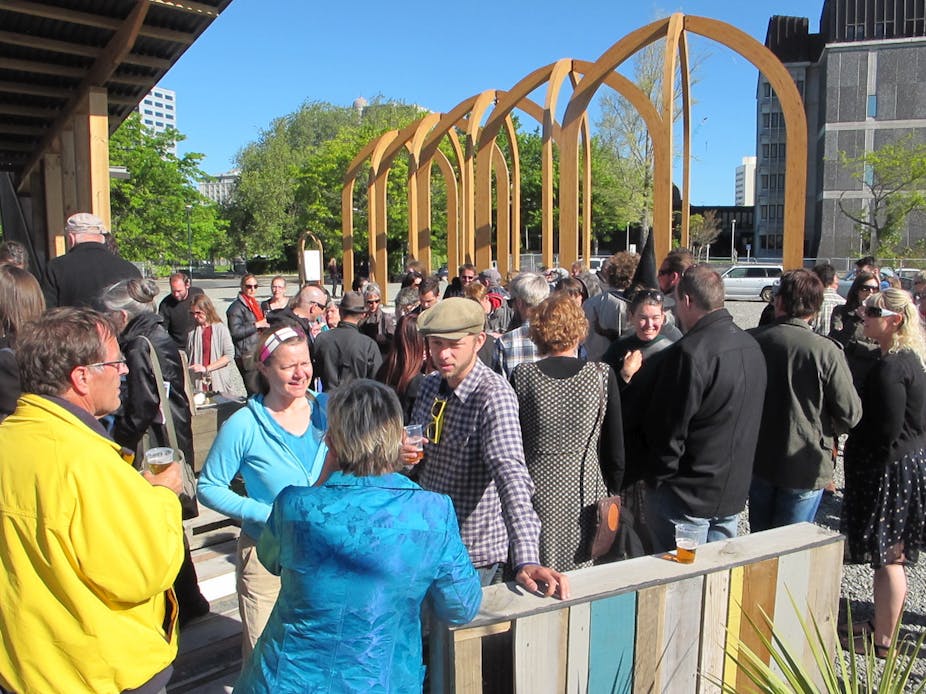February 22 is the third anniversary of the powerful earthquake that killed 185 people and radically altered the New Zealand city of Christchurch. The city centre is flattened and empty, with thousands still waiting for houses and roads to be repaired. The adrenaline and anger that characterised the first two years is gone, only to be replaced by a strange sort of collective bewilderment.
There is enormous complexity in significantly altering the infrastructure of a city after a disaster while at the same time trying to keep its various cultural, physical and environmental networks alive. But there is a strong artistic community adapting to this new post-quake world …

Central city demolition zone
The total cost of the rebuild is around $NZ40 billion, funded by insurance, new investment, and national and local governments. In 2011 the government created a large new authority ministry called the Canterbury Earthquake Recovery Authority (CERA) to lead the recovery process, including the master planning of the central city.

It is sad and strange to walk through the city now, and to see how a plan that was initially designed to provide certainty, speed up processes, and avoid red tape, has become so confused and delayed.
Flowers are placed on the tops of the city’s many traffic cones as a prominent gesture to commemorate the anniversary. It is a symbolic act that also neatly reflects the state of the city at the moment.
Former Cabinet Minister Philip Burdon recently wrote in The Press about the failings of CERA:
Its primary mandate was to streamline bureaucracy and accelerate decision-making. Three years later it has become the antithesis of exactly that. Its most conspicuous failure has been its well-intended ambition to kick-start and accelerate the revival of the CBD.

The central city has had around 1,200 – or 80% – of its buildings demolished, including more than 200 heritage buildings. The large-scale interventions being led by the government are still two to five years away from completion.
Much of what made up the CBD before the earthquake has survived by relocating outside of the centre: sports facilities, businesses, education institutions and manufacturing areas are all doing relatively well.
Even with the destruction of the central city the economy is bustling, and despite the demolition of more than 10,000 houses, Christchurch’s population has only shrunk by around 2%.
Adaptive cultural ecology
Christchurch’s cultural amenities, which were almost entirely based in the central city, have not fared well. Theatres, galleries, music venues, residencies, studios, rehearsal spaces, and bars for live music are now rare and have had to either move or close.
The smaller organisations used to occupy lower-grade spaces that have been demolished. Institutional spaces such as the Christchurch Art Gallery are undergoing extensive repairs that will take years to complete. Some existing organisations such as The Court Theatre, New Zealand’s first professional theatre company founded in 1971, have bucked this trend and flourished in new temporary spaces on the outskirts of the centre.

Given the radical shifts in the cultural ecology of the city, it is surprising (or perhaps not) that what remains of the arts community has become a highly visible part of the rebuild narrative.
Hundreds of temporary and transitional projects continue to pop up in the city. International interest in forms of adaptive urbanism and temporary architecture have led to media outlets such as The New York Times and Lonely Planet hailing the vibrant and innovative nature of this projects as a symbol of recovery.
And, in some ways, they are. Many diverse projects have been developed by visual artists, musicians, architectural historians, designers, performers, project managers and the public in its many forms and shades.
Prominent among these is urban regeneration initiative Gap Filler, which has now led more than 100 projects including their flagship pallet pavilion, and their popular washing-machine powered dance-o-mat.
Life in Vacant Spaces, a council funded brokerage loosely based on the Renew Newcastle model, matches ideas with empty sites.

The Social is an arts collective creating small and frugal interventions into the strange cityscape. One favourite among these is the careful landscaping of weeds on empty sites by a group called Plant Gang.
Each October since the 2012, the Festival of Transitional Architecture has brought tens of thousands into the broken city and has helped shepherd major works such as the large-scale work of transitional architecture The Arcades Project and urban farming project Agropolis.
Despite losing their funding and theatre space, performers Free Theatre continue to have strong presence in the city.
These projects are novel, interesting, fun, visually effective and – to my mind – even important.
Will they make a meaningful and lasting impact on the re-imagining of the city? At the end of 2013, local journalist John McCrone summed it all up well by saying:
Yes, another year, another confused blur, most likely. Come back for a clearer analysis some time around 2024.

